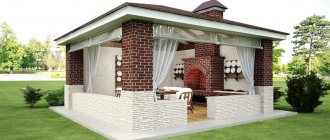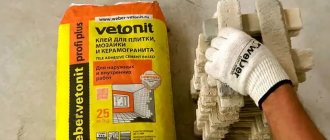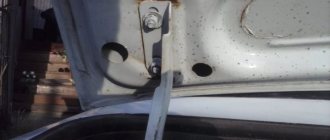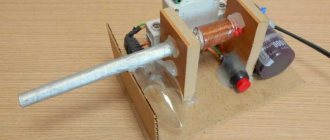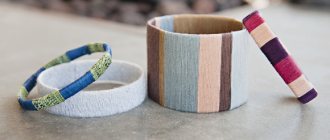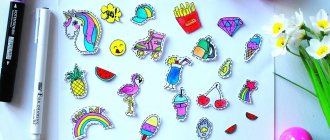We make display cases for a collection of anything ourselves
We offer several such display cases. A box with lighting can be installed on a coffee table (see Fig. 1). Make the box itself using chipboard scraps, veneered or covered with synthetic film.
The exhibits are placed on frosted glass, under which fluorescent lamps are placed, and covered with transparent glass on top. Frosted glass is placed on the console, and transparent glass is inserted into the groove, which is formed by a baguette glued to the walls.
The assembly diagram is shown in Figure 2. It is more convenient to do it this way. Drill holes for wooden pins in the prepared ones. Apply glue to the parts that form the corner and insert the rods into the holes. Attach the other walls in the same way. Press them tightly together. Use a square to check if the corners are right. And fix it crosswise with two slats until the glue dries. The frame support is made in the same way. When assembling, strengthen the support bars inside the box to support the matte screen. To do this, drill holes with a diameter of 2.5 - 3 mm in the places where the screws are installed in the bars. Secure the bars. Insert and secure with screws. Install the bottom using thin screws. It contains 3-4 fluorescent lamps with a power of 20 W and a starter. Connect the wires to them, connect the lamps to the throttle and starter and check their operation. All that remains is to cut out two rectangular glasses. Place frosted glass on the support bars above the lamps, and cover the entire structure with transparent glass.
But before assembly, do not forget to carefully finish all the parts. Sand the surfaces with sandpaper. Rub with wax or mastic, or even better, cover with 2 - 3 layers of furniture varnish, leveling each previous layer with fine sandpaper.
Another showcase will serve to display a collection of tin soldiers, car models, and other similar items.
Prepare several well 20 mm thick and 150 - 200 mm wide, a sheet of hardboard, wooden slats and two glasses - frosted and transparent, according to the dimensions indicated in the figure. Frosted glass will go on the vertical wall covering the lamps, and shelves and front sliding halves of the display case are cut out of transparent (window) glass (Figure 3).
The assembly sequence is as follows. Cut grooves in the vertical walls. It is quite difficult to perform this operation manually, so prepare a template in advance and practice on some unnecessary board. The template consists of two metal strips or corners in which grooves are cut with a width corresponding to the thickness of the shelf. Using two clamps, the templates are attached to, and with a hacksaw (the width of the teeth must correspond to the thickness of the glass), cut the recesses in the selected places.
Traditionally - on spikes. The vertical walls are fastened with screws. 3 fluorescent lamps with a power of 20 W each are installed on a hardboard board and covered with frosted glass. You can, of course, place it directly on the wall, but this will require drilling holes. And that's not so bad. When the need arises to move the display case, you will have to drill new ones and seal the old ones.
Glass shelves, like outer glass, are inserted when the display case is fixed. All that remains is to place the exhibits and install sliding windows. Remember that heavy objects can crush a glass shelf, so do not overuse it.
These display cabinets and bookcases share a common basic cabinet element. If desired, a home craftsman can decorate one of the rooms of his apartment with a piece of furniture he likes.
Any of the two items under consideration is fully consistent with modern trends in furniture making. The combination of natural wood color and black trim details characterizes their design. The ash panel details beautifully frame the dark shelves and give the product a noble touch. Such a cabinet largely determines the character of the interior.
A simpler product is a bookcase. Its appearance is quite austere. This impression is reinforced by intermediate shelves made of natural wood.
The design of a display cabinet in comparison with a bookcase is more complex, since it contains some additional elements - three drawers, two glass doors at the top of the cabinet, a triangular cornice. In addition, here it will be necessary to install lighting using halogen lamps and place a step-down transformer behind the eaves.
The display part of the display cabinet is closed with two glass doors. At the bottom there are three large drawers with wooden front panels.
The bookcase design with light wood details is characterized by strict, clean lines.
Specifics of glass cabinets for bathrooms
A glass bathroom cabinet has a lot of properties:
- Unusuality. The original appearance is associated with the transparency of the material. Ideal for any style;
- Long service life. If the glass is not subjected to overloads and shock influences, then its service life is unlimited;
- Neutrality. The material has absolutely no contact whatsoever. It does not absorb water, is not afraid of heat, and tolerates washing with household chemicals;
- Eco-safety. Complete absence of reactions with the external environment. Does not release any toxins;
- The ability of glass to transmit and diffuse light will make the bathroom brighter;
- Does not require special care;
- A huge number of finishing options allow you to give the glass a completely original look.
Installation of glass doors
For lightweight glass doors (as in this case), you can use screw clamp hinges. Larger doors should be hung on screw-on hinges. To do this, you need to drill holes in the glass (preferably in a glass workshop) to attach the hinges.
It is best to cut the wood slab with a hand-held circular saw with a rip fence or along a guide rail.
Four holes for shelf holders are drilled in the side walls at several levels. An electric drill is installed on a drilling fixture.
The side walls are glued together from two wood slabs through bars with a cross-section of 20x20 mm. If desired, instead of ash decoration elements, you can use beech or pine.
Each of the load-bearing side walls of the basic structural element consists of two veneered wood boards (or chipboards) with bars glued between them with a cross-section of 20x20 mm. The inner plate of the side walls is 10 mm narrower than the outer one, due to which a kind of fold is formed on the back side, allowing the rear wall to be installed flush with the rear edges of the outer plates of the side walls. The front edges of the walls are covered with platbands, which are fastened as follows. A block is glued to the back side of the platband, which is then glued between two slabs forming the side walls. The platbands are attached only after finishing the body elements.
The housing cover is secured on top with screws (three screws on each side). Holes for screws must be drilled strictly in the middle of the edges of each of the inner plates of the two-layer side walls.
Before starting to assemble the cabinet, all parts of its body are first finished with black stain using a wide brush, then sanded, treated with primer and finally varnished.
The base of the cabinet is assembled from three parts, which are sawed down and secured from below with screws. The bottom is attached from above to the side support bars. The back wall is inserted into the “rebate” and secured with screws.
Vertical trims are installed after finishing. Having applied glue to the contacting surfaces, insert the bars attached to the platbands from the back side between the side wall plates and tighten these elements with large clamps.
A wooden shelf separates the upper, display part of the cabinet from the lower part with drawers. This shelf is mounted secretly on support bars screwed to it from below. Drawers move along telescopic guides attached to the side walls.
Large drawers of the display cabinet. Narrow strips of light wood, finished with furniture wax or clear varnish, contrast effectively with dark drawer fronts.
To make a display cabinet (or bookcase) look really beautiful, you should choose the right materials necessary for its manufacture. In this case, the side walls of the cabinet are made of 19 mm thick wood board, veneered. The cabinet lid and drawer bodies are made from the same material.
All front parts (drawer panels, platbands and triangular cornice), as well as the bottom and shelves, are cut out of 18 mm thick ash wood board. For the back wall, plywood with a thickness of 10 mm is quite suitable.
Glass doors and shelves (glass thickness - 6 mm) are best cut in a glass workshop. Here their edges will be sanded.
Fittings: 6 telescopic guides for drawers; 4 hinges for fastening glass doors.
Before finishing, the cabinet is assembled to assess the correct fit of the elements, and then disassembled. All panel parts and drawer fronts are stained black, sanded, primed and coated with a clear matte varnish. The final assembly of the cabinet is carried out after finishing its elements.
Make two pull out trays
W from 18 mm boards X from 12 mm boards . We used poplar wood. Then, to form the connections (Fig. 7 and 7a), follow the three-step operation (Fig. 8). Cut out the tongues to insert the bottom Y.
2. Cut a Y for each of the trays. Dry assemble the trays to check the fit of the parts. Disassemble them and sand the bottom, as well as the inner sides of all walls W, X. Glue the trays together and make sure they are square. Once the glue is dry, sand the outside of the trays.
Z
support strips for the pull-out guides. Glue two of them to the uprights of the side frames A and the front frame I in the inner front corners of the body (Fig. 9). At the rear of the chassis, position the support bars so that they line up with the last mounting hole in the ball slides. Glue the rear supporting strips to the rear side pillars, securing them with clamps.
Natural wood finishing
Instead of clear varnish, wooden parts can be coated with liquid furniture wax, which is applied with a brush and rubbed with a swab.
The chinchilla is a touching and sweet creature that needs a lot of care and attention. The life expectancy of the animal directly depends on how well it is cared for and how comfortable its living conditions are. Zoologists advise keeping chinchillas in a special display cage.
We have collected tips on how to make a showcase yourself and how to arrange it in this article.
A display case for a chinchilla today is a more popular option for keeping an animal than a cage, although it is more expensive in terms of price and care. In order for an animal to feel comfortable and protected, it needs its own closed home.
And the showcase is best suited for these purposes. It is spacious, looks very beautiful, unlike, for example, a metal cage, and can be made of various materials, including natural ones. Chinchillas really like such corners, especially those made of wood.
A showcase has several advantages over a cage:
- It creates less noise.
- No debris spills out of it.
- It's easier to clean.
- It looks more interesting in the interior - you can, for example, choose a color to match the furniture in the room.
- When installing the enclosure on wheels, it can be moved to any corner of the room, for example, when rearranging furniture.
Among the disadvantages of a wooden display case is the absorption of odor and moisture, which makes it short-lived. Display cages are made from the following materials:
Prevention and care of display cases
Cosmetic cleaning including washing the toilet, drinking bowl, and feeder must be done daily. If there is no tray, the litter should also be changed daily. If the chinchilla is litter box trained, the bedding is changed once a month.
Video: how to clean a chinchilla's window display
General cleaning is done once a week. In order to do it, the chinchilla needs to be removed from the enclosure and placed in a carrier. Then remove all loose objects: house, tunnels, etc.
Did you know?
To scare the enemy, the chinchilla stands on its hind legs and shoots a stream of urine at it.
And if a predator grabs her, she can shed scraps of fur in order to escape. After this, you can start cleaning up the debris using a vacuum cleaner. Then wash the bottom of the display case with a weak soda solution and a sponge, and wipe the floor dry.
Side walls and doors should be wiped with a damp cloth and also wiped dry. All items that were in the middle of the display case should be thoroughly washed, dried and placed in their places.
If you need to disinfect the room, you will need to use special products purchased at a pet store.
Surely most chinchilla owners purchased it in order to be touched by this fluffy creature. Therefore, each of the breeders is simply obliged to repay the pet with a good attitude, quality care and the creation of comfortable living conditions. After all, the life expectancy of an animal directly depends on these factors. A home for a chinchilla in the form of a display case can be either purchased or made with your own hands. To make your pet feel comfortable in it, it is important to follow the recommendations for its area and arrangement.
The success of trade is not only a quality product, but also the ability of the seller to present it in the most attractive way. A variety of display equipment can help in this matter.
You can get acquainted with the assortment of display cases and order the option you like on the website: https://otilos.ru/trade-equipment-saratov/. What kind of commercial equipment is there? What materials are used to make it, and which material is preferable?
How to build a shopping pavilion with your own hands drawings
Usually ready-made slabs are used, but sometimes prefabricated structures are also used. The technologies considered are quite often combined. Sandwich panels allow you to build a building in the shortest possible time, and they can also be used to build a large store. Interesting Facts! For successful trade, the speed of trade turnover and the ability to open or move a pavilion as quickly as possible are of great importance. Store mobility is extremely important, especially when it comes to seasonal trading. Therefore, when constructing a kiosk, it is recommended to give preference to lightweight materials, but with good strength. Pavilion construction procedure In order to build a pavilion with your own hands as quickly as possible, it is recommended to use sandwich panels. Their installation is quite simple, so the work can be done without the help of specialists. The procedure for constructing the pavilion is as follows:
Types of models
The models differ from each other in shape and size. There are several key types:
In the next article we will talk about the topic of a photo cabinet built into a photo wall. Let's try to describe this topic in more detail.
- Floor-standing. They can be ceiling-mounted or shortened (without the top part). Height ranges from 72 to 210 cm. Recommended width can vary between 30 – 40 cm;
- Wall. In this case, the standard height dimensions do not go beyond 72 cm. The width ranges from 30 (narrow) to 80 (elongated) cm;
- Angular. The average parameters for them do not differ from other species.
The recommended depth for all glass cabinet options is 25 - 28 cm. Deeper options usually create problems with the placement and fastening of shelves.
Glass cabinets are an excellent option for creating a unique, original bathtub design. At the same time, the quality of storage of things is maintained at height. If handled correctly, the cabinet will serve you faithfully for a very long time.
DIY bathroom cabinet with mirror with LM part 2
Where is the best place to put a buffet?
Here are some instructions, or rather recommendations, on this matter from professional designers:
- If your kitchen is spacious, then the dining buffet will look harmonious near the dining area near the table or opposite the entrance to the kitchen. In this case, the guests’ attention will immediately fall on the original sideboard with beautiful dishes or other decorations.
- If you have a separate dining room, then, of course, it is better to place a large buffet there.
Placing a buffet in the dining room
- For studio apartments, a so-called buffet bar is suitable. It can become a kind of space delimiter. With its help, you can successfully divide the room into a cooking area and a living room. In addition, with such furniture, you will not have to break away from the conversation during the cooking process, and prepared dishes and drinks can be served directly through the buffet.
Bar buffet
- But even if you have an apartment with a small kitchen space, you don’t need to deny yourself the pleasure of installing such beauty. A sideboard can be used to “fill” a non-functional niche in the wall or a dead “dead corner”, as you can see in the photo below.
Corner model
Types of showcases
Commercial equipment such as display cases and counters are the most common and in demand. The vast majority of stores use this type of equipment to organize their work.
All showcases can be classified according to various criteria:
products made from chipboard and glass - the “classic” option, inexpensive and practical; glass showcases - such equipment, on the one hand, allows you to demonstrate the product from all sides, on the other hand, it is quite fragile and not resistant to mechanical damage; metal commercial equipment – strong and durable; combined products consisting of chipboard, metal profile and glass - an excellent option, durable, strong and easy to assemble;
rectangular; trapezoidal; round; corner;
- location in the sales area:
wall-mounted – installed along one or several walls; island – standing separately in different parts of large trading floors.
Frame of a trade pavilion made of wooden beams
For the installation of additional stiffening ribs of the supporting frame of the pavilion, profile pipe with a cross section of 50x25 mm is well suited. The wide edges of pipes of this size make it easy to attach sheathing to them. For convenient joining of pipes to each other, it is recommended to select additional frame parts from products with a smaller cross-section than the professional pipe for assembling the frame; in this case, a 40x20 mm profile pipe is suitable. In addition to corrugated pipes, you will need other finishing materials.
*see section 3.2 - “Installation of the kiosk”.
Most kiosks are frame metal structures consisting of profile pipes, angles, and channels. The frame is a kind of skeleton of the kiosk. It must be rigid to withstand the load during construction and transportation.
Bottom chord of the frame (base). When the width of the kiosk is 3 meters or less, corners are used. When the width of the kiosk is more than 3 meters, a channel is used.
At the base there is an additional crossbar for every meter for greater rigidity. Frame racks (pillars). The most commonly used are corners. The main ones are placed in the corners - 4 pieces. All metal structures are connected by welding. There are two types of frame, depending on what the walls will be made of.
The first type: a wall made of factory-made sandwich panels - frameless. The second type: prefabricated sandwich panel - frame (layer-by-layer production).
Pros and cons of the design
What advantages, besides beauty, does a glass table have? It is easy to care for: a household mirror cleaner will do. Glass is one of the few materials that does not absorb odors, and there are no permanent marks left on its surface from drinks or hot objects.
The glass table is easy to care for.
Transparent or painted countertops will not fade, even in direct sunlight. The only drawback is the need for polishing. If high-strength glass was chosen to make the table, then the product is unlikely to break under the influence of normal mechanical loads.
Source

